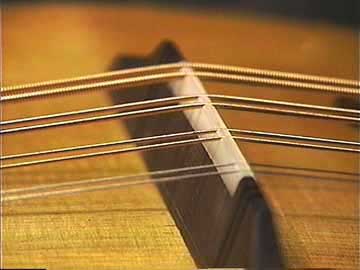Compensation
© Frank Ford, 9/6/98 Photos by FF
Because you can't move frets around as you play, their placement is critical to playing in tune. Just as critical is the vibrating string length, which may need to be adjusted differently for different strings and tunings.
The tops of bridges or saddles are often "compensated" or cut to adjust the vibrating string length. The luthier is compensating for the fact that different strings stretch differently as they are pressed down to the frets. As they stretch, they become sharper in pitch, requiring that the vibrating length be adjusted accordingly.
Here's the look of a compensated bridge:

This mandolin bridge has the typical compensation.
This mandolin bridge has no compensation:

Mandolins are particularly sensitive to compensation because the strings are so short!
This is a typical steel string guitar saddle, without compensation:

For better intonation, this guitar has a compensated saddle:

The amount of compensation varies with the string diameter and tuning. Players who play in unusual and "dropped" tunings may find they have greater need for compensation in those tunings. Some musicians have instruments set up with special compensation and use them for certain tunings only.
Back to Glossary
Back to Index Page